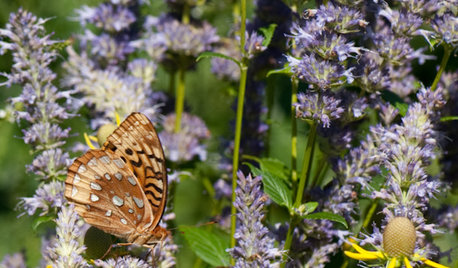Licorice . . . I like it and I don't like it
leftwood
18 years ago
Related Stories

GARDENING GUIDESGreat Design Plant: Anise Hyssop Delights Licorice Lovers
With its distinct scent and flower spikes, drought-tolerant Agastache foeniculum stirs interest among humans and winged creatures alike
Full Story
LIFEYou Said It: ‘Just Because I’m Tiny Doesn’t Mean I Don’t Go Big’
Changing things up with space, color and paint dominated the design conversations this week
Full Story
COFFEE WITH AN ARCHITECTA Few Things I Would Like to Ask Frank Lloyd Wright
It could take a lifetime to understand Frank Lloyd Wright's work — less if we had answers to a few simple questions
Full Story
LIFEYou Said It: ‘They Looked at Me Like I Had 10 Heads’
Design advice, inspiration and observations that struck a chord
Full Story
LIGHTING10 Chandeliers for People Who Don't Like Chandeliers
Get all the chandelier benefits without channeling Liberace, thanks to wood, paper, wire — and even a surprising old-fashioned staple
Full Story
FURNITUREObjects of Desire: Recliners That Don’t Look Like Recliners
Forget bulky, hulky eyesores. These 7 smart and svelte chairs — some without levers — have mastered the art of disguise
Full Story
When a Column Doesn't Look Like a Column
See Why Designers May Opt for Tree-like Supports in Wood or Steel
Full Story
MORE ROOMSRooms I'd Like to See Wrapped Up as Gifts for the Holidays!
What Room Do You Have on Your Gift List This Year?
Full Story
DECORATING GUIDESI'll Have the Same: How to Design With Monochromatic Color
Indulge the eye, offer a break from visual chaos and make decorating easier with single-color rooms in any shade you like
Full Story
PRODUCT PICKSGuest Picks: In Like a Lion, Out Like a Lamb
Take a cue from the classic adage about March with home accessories that call these animals to mind
Full Story





abgardeneer
leftwoodOriginal Author
Related Professionals
Danbury Landscape Architects & Landscape Designers · Ashburn Landscape Architects & Landscape Designers · Franconia Landscape Architects & Landscape Designers · Oconomowoc Landscape Architects & Landscape Designers · Mooresville Landscape Contractors · Addison Landscape Contractors · Brandon Landscape Contractors · Cerritos Landscape Contractors · Indianapolis Landscape Contractors · La Vista Landscape Contractors · North Chicago Landscape Contractors · Saint Paul Landscape Contractors · St. Louis Landscape Contractors · West Covina Landscape Contractors · West Orange Landscape Contractorszenpotter
Julie
abgardeneer
Julie
leftwoodOriginal Author
Greenthumb